目录
- 前言
- 一、认识vector
- 1. 介绍
- 2. 成员类型
- 二、默认成员函数(Member functions)
- 1. 构造函数
- 2. 拷贝构造函数
- vector (const vector& x);
- 3. 析构函数
- 4. 赋值运算符重载函数
- 三、迭代器(Iterators)
- 1. 普通对象的迭代器
- 2. const对象的迭代器
- 3. 普通对象的反向迭代器
- 4. const对象的反向迭代器
- 四、容量接口(Capacity)
- 1. size()
- 2. capacity()
- 3. reserve()
- 4. resize()
- 五、元素访问接口(Element access)
- 1. operator[]
- (1)reference operator[](size_t n)
- (2)const reference operator[](size_t n)const
- 2. at()
- (1)reference at() const
- (2)const reference at(size_t n) const
- 3. front()
- 4.back()
- 六、修改接口(Modifiers)
- 1. push_back()
- 2. pop_back()
前言
一、认识vector
1. 介绍
vector是一个支持动态扩容的数组,并且是以模板进行支持的,所以可以实现存储不同类型的数据,实用性比较广。

2. 成员类型

二、默认成员函数(Member functions)
1. 构造函数

标准库中的vector支持了很多版本的构造函数,但是在实际的使用过程中比较常用的是无参的构造函数。
- 代码1:无参构造函数
int main()
{vector<int> v1;vector<double> v2;vector<string> v3;return 0;
}
调试结果:

- 代码2:使用n个数据进行构造
int main()
{vector<int> v1(6, 8);vector<double> v2(5, 6.6);vector<string> v3(6, "hello std::vector");return 0;
}
调试结果:
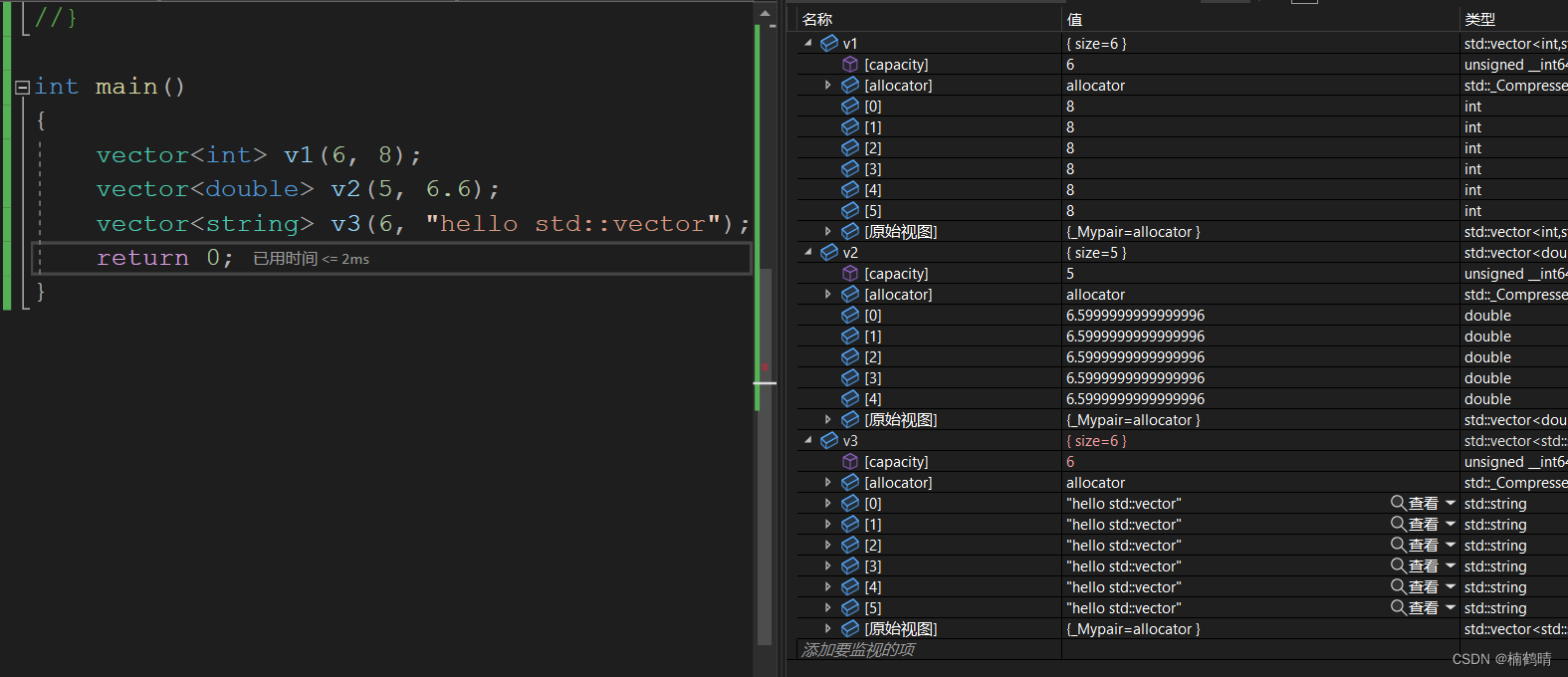
- 代码3:使用一个迭代器区间进行构造
int main()
{string s("hello std::vector::vector(iterator begin,iterator end)");vector<char> v(s.begin(), s.end());for (auto e : v){cout << e << " ";}cout << endl;return 0;
}
运行结果:

2. 拷贝构造函数
vector (const vector& x);
vector的拷贝构造函数需要实现成深拷贝,其用法和其他类基本类似
- 代码:
int main()
{string s("hello std::vector::vector(iterator begin,iterator end)");vector<char> v(s.begin(), s.end());vector<char> v1(v);for (auto e : v){cout << e << " ";}cout << endl;for (auto e : v1){cout << e << " ";}cout << endl;return 0;
}
运行结果:
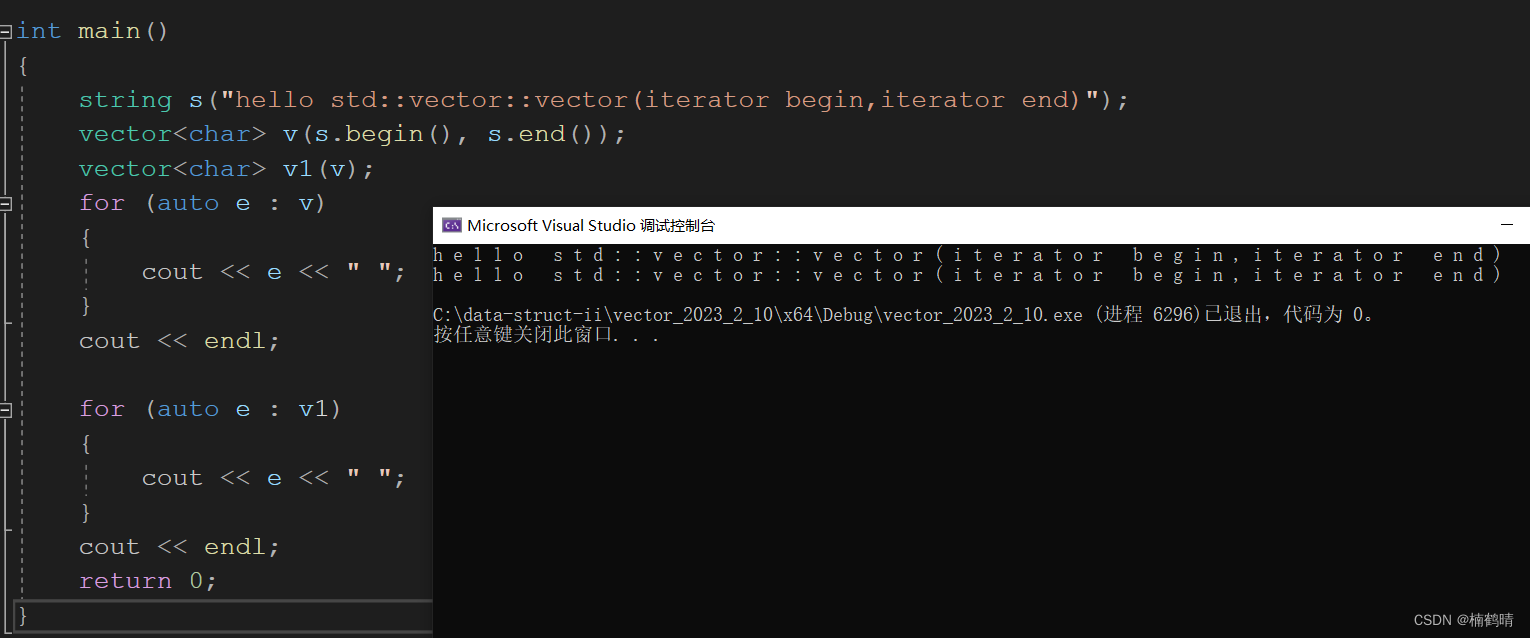
3. 析构函数
vector中有动态申请的资源,所以需要手动实现析构函数在函数生命周期结束时自动调用该析构函数完成资源的释放。
4. 赋值运算符重载函数

赋值运算符重载函数需要实现的也是深拷贝,下面介绍其用法:
- 代码:
int main()
{string s("hello std::vector(const vector<char>&v)");vector<char> v1(s.begin(),s.end());vector<char> v2;v2 = v1;cout << "v1:" << endl;for (auto ch : v1){cout << ch << " ";}cout << endl;cout << "v2:" << endl;for (auto ch : v2){cout << ch << " ";}cout << endl;return 0;
}
运行结果:

三、迭代器(Iterators)
1. 普通对象的迭代器
普通对象一般调用的就是普通的迭代器,迭代器的一个很重要的作用就是遍历数组,同时范围for的底层原理就是迭代器
- 代码1:遍历
int main()
{string s("hello std::vector::iterator begin() and end()");vector<char> v(s.begin(), s.end());vector<char>::iterator vit = v.begin();while (vit != v.end()){cout << *vit << " ";vit++;}cout << endl;for (auto& ch : v){cout << ch << " ";}cout << endl;return 0;
}
运行结果:
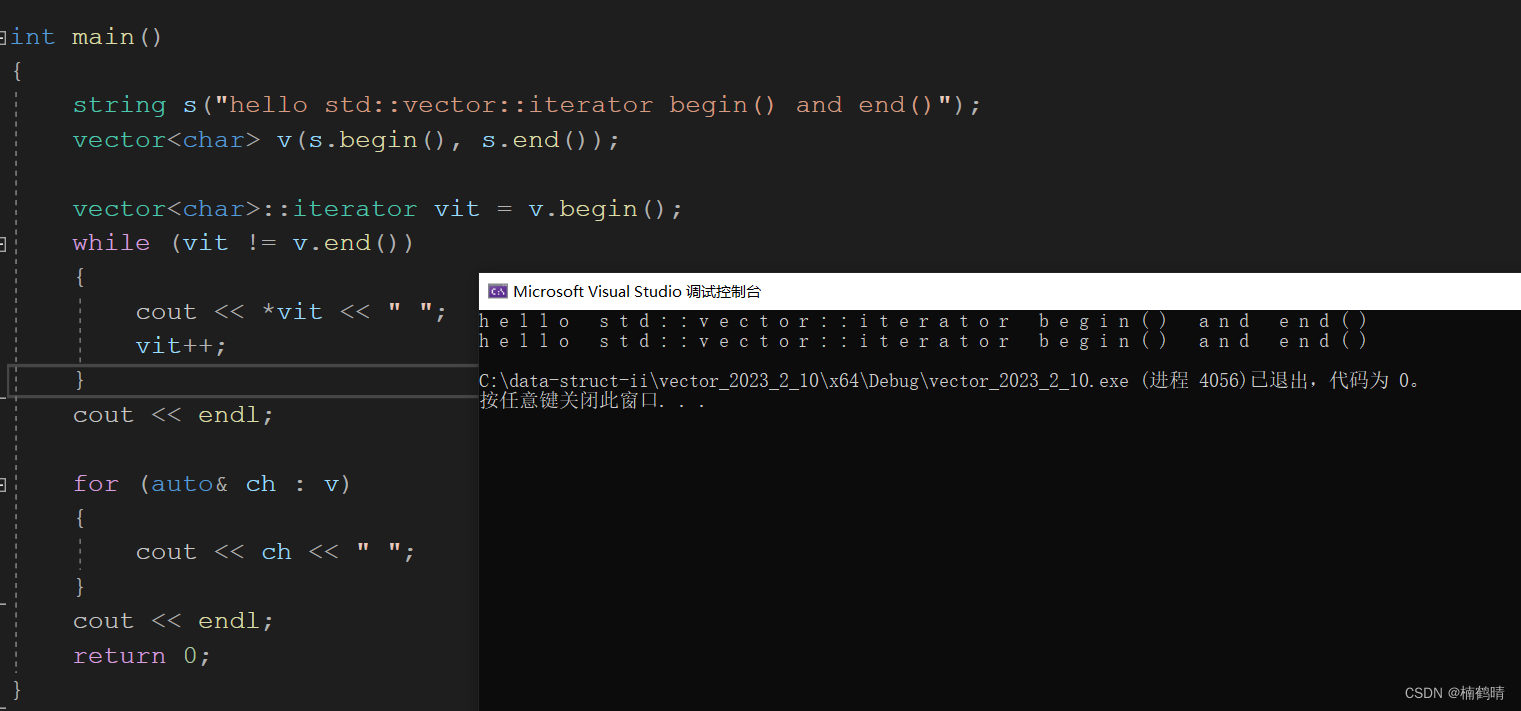
- 代码2:支持修改
int main()
{string s("hello std::vector::iterator begin() and end()");vector<char> v(s.begin(), s.end());vector<char>::iterator vit = v.begin();while (vit != v.end()){(*vit) += 1;cout << *vit << " ";vit++;}cout << endl;for (auto& ch : v){cout << ch << " ";}cout << endl;return 0;
}
运行结果:
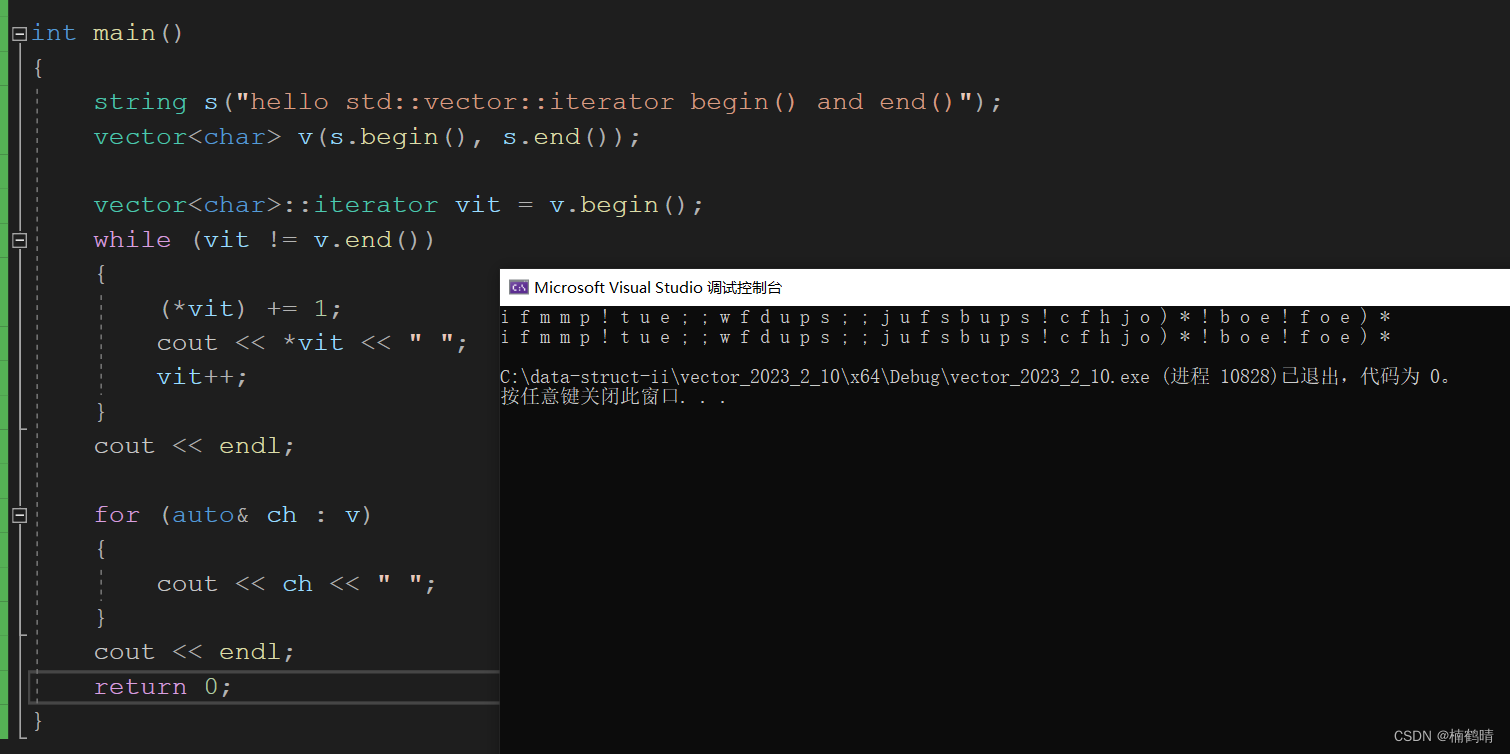
2. const对象的迭代器
const类型的对象调用const版本的迭代器,不支持修改,支持遍历容器
- 代码:
int main()
{string s("hello std::vector::const_iterator begin() and end()");const vector<char> v(s.begin(), s.end());vector<char>::const_iterator vit = v.begin();while (vit != v.end()){cout << *vit << " ";vit++;}cout << endl;return 0;
}
运行结果:
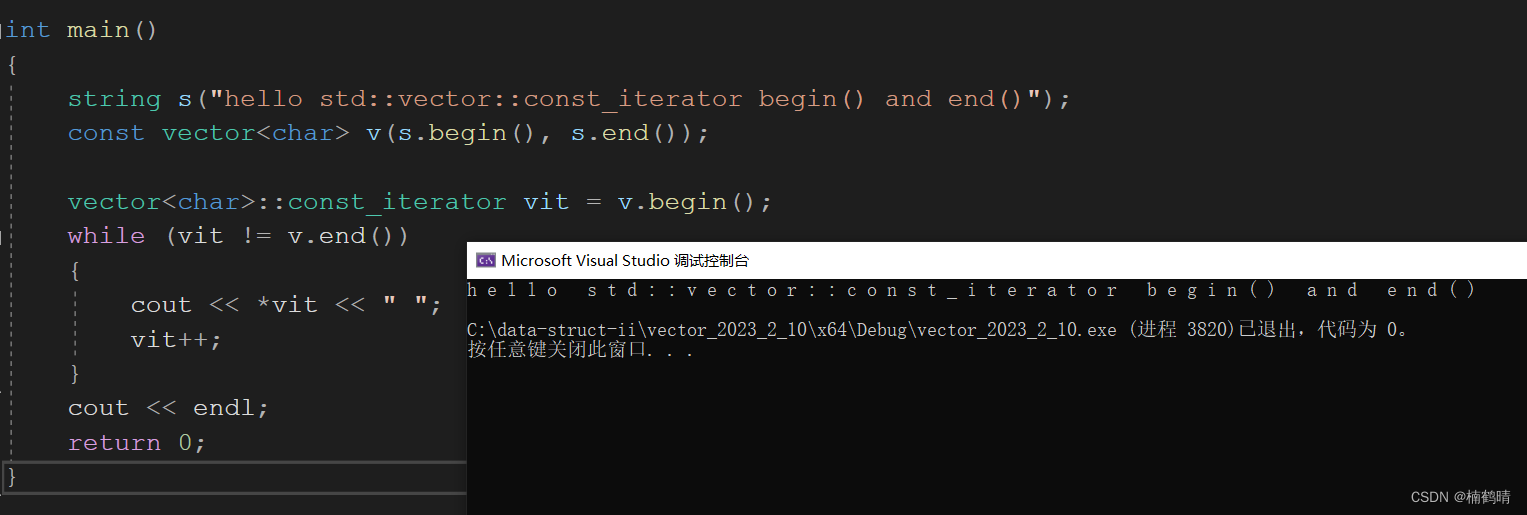
- 代码2:不支持修改

3. 普通对象的反向迭代器
- 代码:
int main()
{string s("hello std::vector<char>::iterator rbegin() and rend()");vector<char> v(s.begin(), s.end());vector<char>::reverse_iterator vit = v.rbegin();while (vit != v.rend()){cout << *vit << " ";vit++;}cout << endl;return 0;
}
运行结果:

4. const对象的反向迭代器
- 代码:
int main()
{string s("hello std::vector<char>::const_reverse_iiterator rbegin() and rend()");const vector<char> v(s.begin(), s.end());vector<char>::const_reverse_iterator vit = v.rbegin();while (vit != v.rend()){cout << *vit << " ";vit++;}cout << endl;return 0;
}
运行结果:

四、容量接口(Capacity)
1. size()

- 代码:
int main()
{string s("hello std::vector<char>::size()");vector<char> v(s.begin(),s.end());cout << "size:" << v.size() << endl;return 0;
}
运行结果:

2. capacity()

- 代码:
int main()
{string s("hello std::vector<char>::capacity()");vector<char> v(s.begin(), s.end());cout << "capacity:" << v.capacity() << endl;return 0;
}
运行结果:

3. reserve()
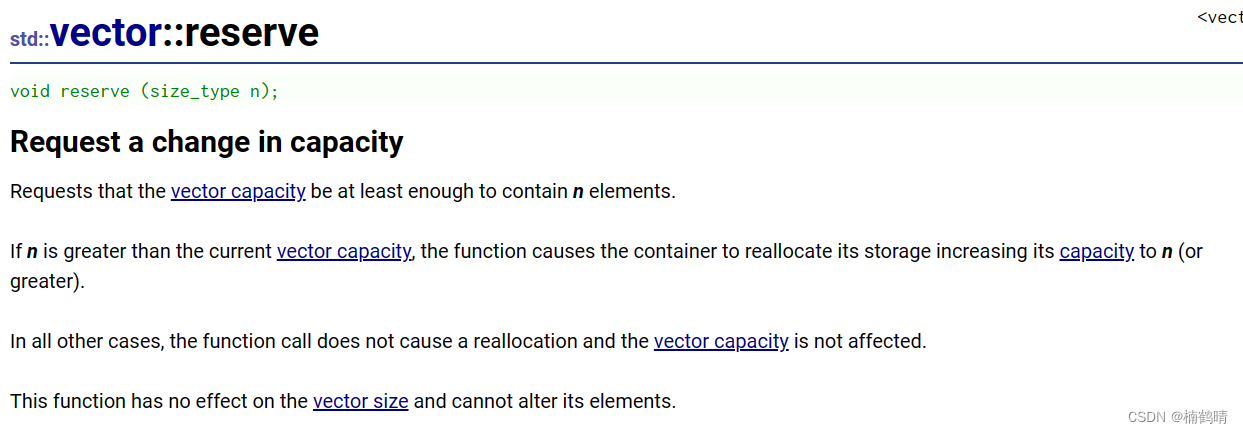
- 代码:
int main()
{string s("hello std::vector<char>::reserve()");vector<char> v(s.begin(), s.end());cout << "capacity:" << v.capacity() << endl;v.reserve(100);cout << "capacity:" << v.capacity() << endl;return 0;
}
运行结果:

4. resize()
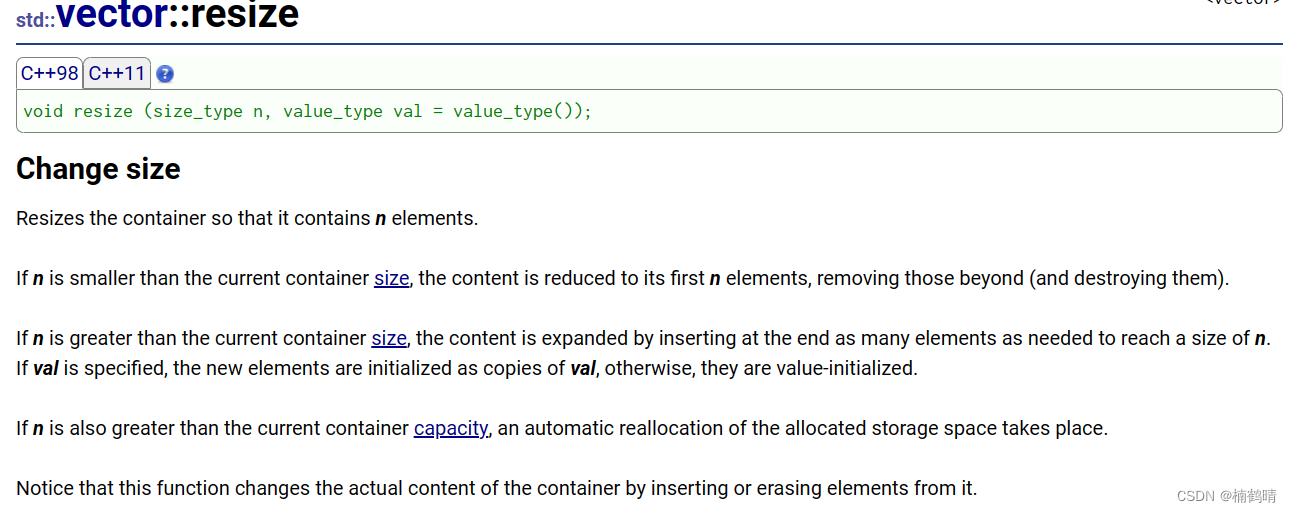
- 代码1:
int main()
{string s("hello std::vector<char>::resize()");vector<char> v(s.begin(),s.end());cout << "size:" << v.size() << endl;cout << "capacity:" << v.capacity() << endl;v.resize(100, 'x');cout << "size:" << v.size() << endl;cout << "capacity:" << v.capacity() << endl;return 0;
}
运行结果:
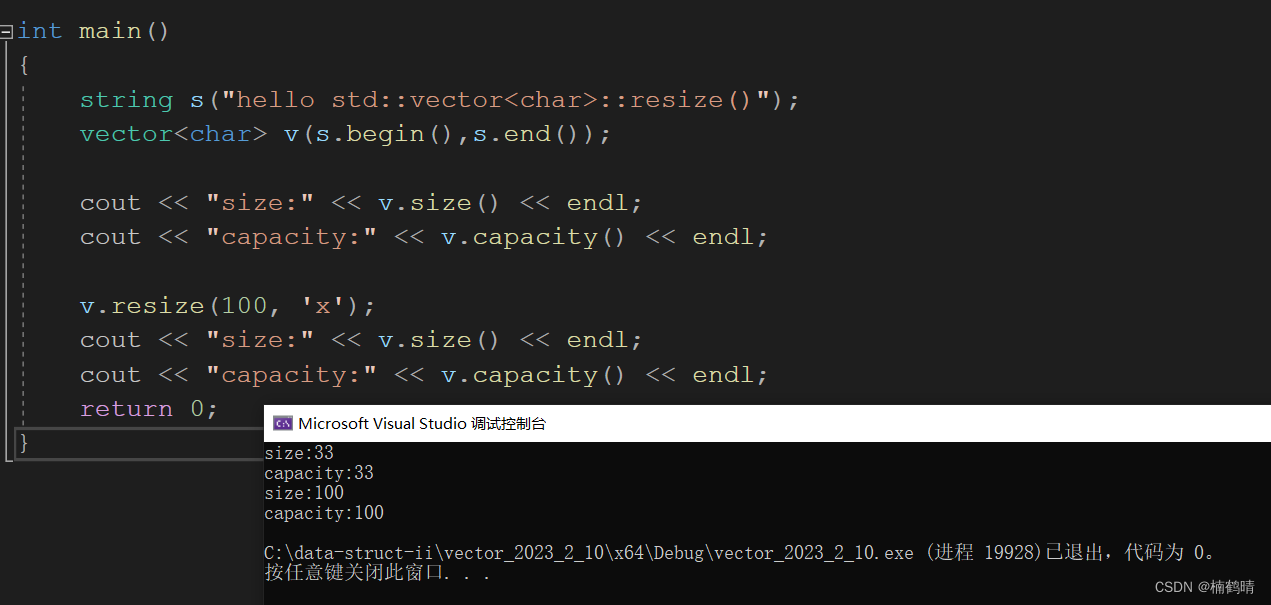
- 代码2:
int main()
{string s("hello std::vector<char>::resize()");vector<char> v(s.begin(), s.end());v.reserve(50);cout << "size:" << v.size() << endl;cout << "capacity:" << v.capacity() << endl;v.resize(46, 'x');cout << "size:" << v.size() << endl;cout << "capacity:" << v.capacity() << endl;return 0;
}
运行结果:
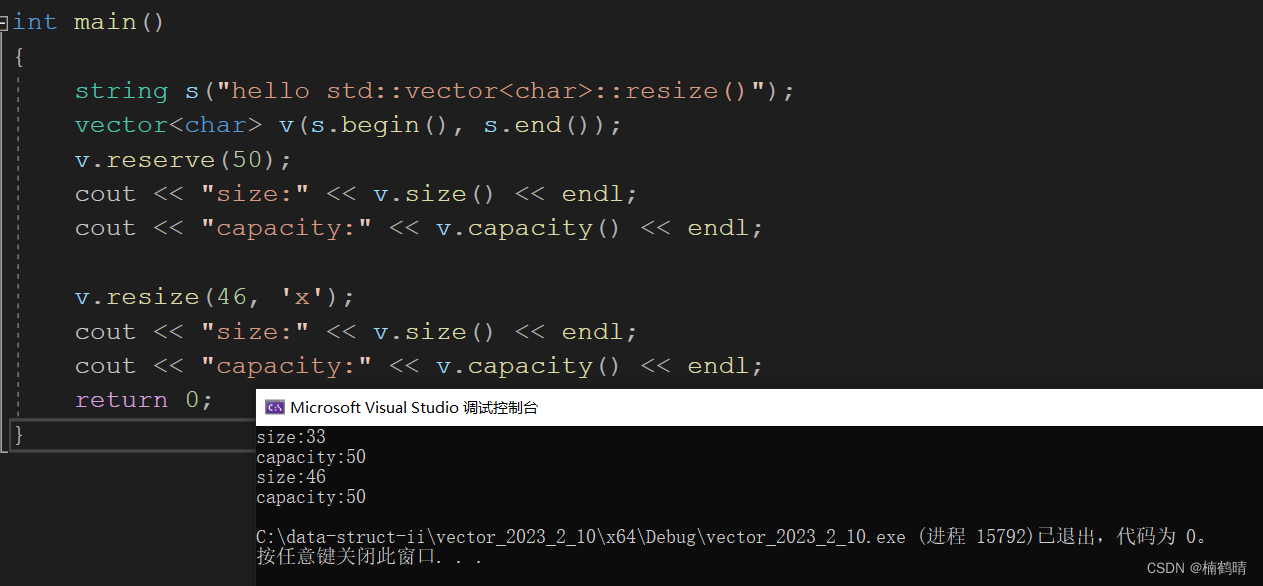
- 代码3:
int main()
{string s("hello std::vector<char>::resize()");vector<char> v(s.begin(), s.end());v.reserve(50);cout << "size:" << v.size() << endl;cout << "capacity:" << v.capacity() << endl;v.resize(23, 'x');cout << "size:" << v.size() << endl;cout << "capacity:" << v.capacity() << endl;return 0;
}
运行结果:
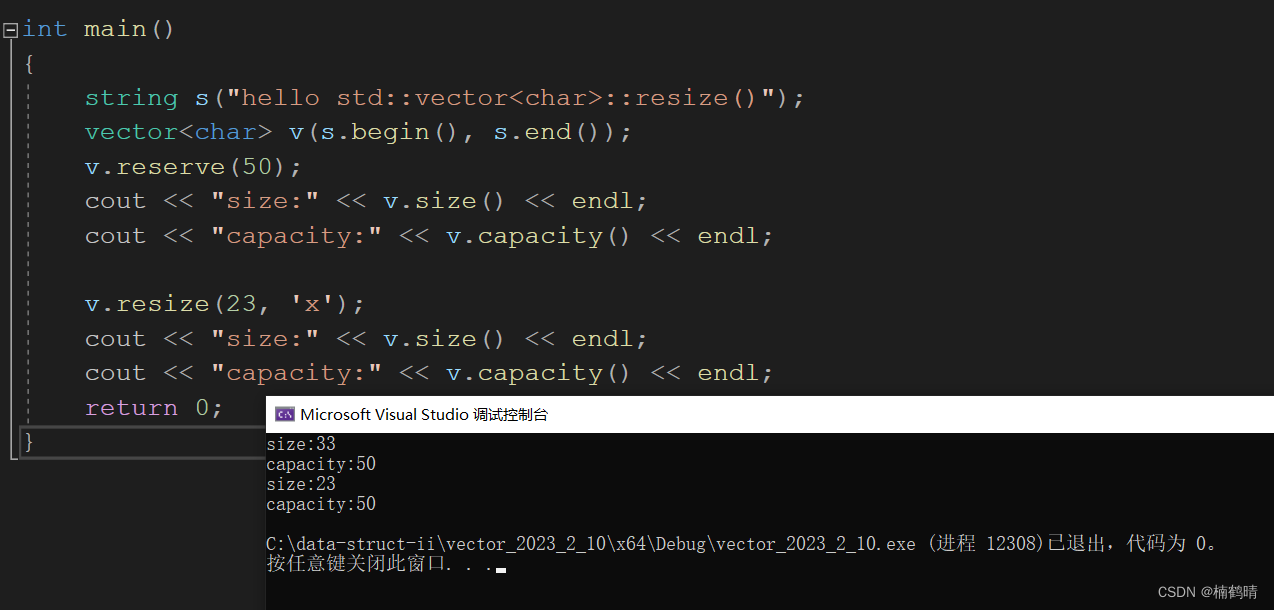
五、元素访问接口(Element access)
1. operator[]

(1)reference operator[](size_t n)
- 代码:
int main()
{string s("hello std::vector<char>::reference operator[](size_t n)");vector<char> v(s.begin(), s.end());for (size_t i = 0; i < v.size(); i++){cout << v[i] << " ";}cout << endl;return 0;
}
运行结果:

(2)const reference operator[](size_t n)const
- 代码:
int main()
{string s("hello std::vector<char>::const reference operator[](size_t n)");const vector<char> v(s.begin(), s.end());for (size_t i = 0; i < v.size(); i++){cout << v[i] << " ";}cout << endl;return 0;
}
运行结果:

2. at()

(1)reference at() const
- 代码:
int main()
{string s("hello std::vector<char>::reference at(size_t n)");vector<char> v(s.begin(), s.end());for (size_t i = 0; i < v.size(); i++){cout << v.at(i) << " ";}cout << endl;return 0;
}
运行结果:
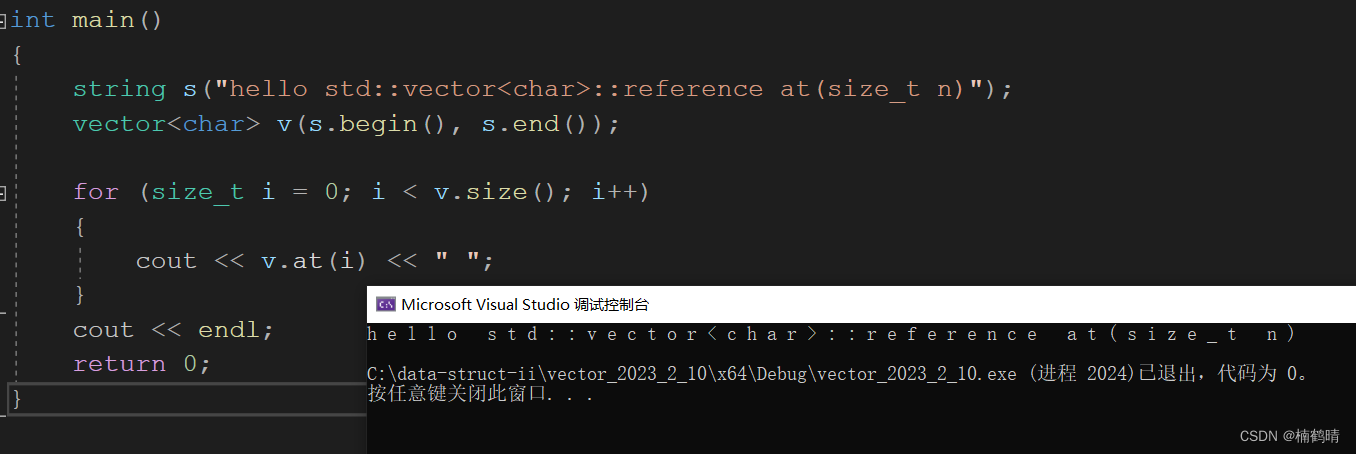
(2)const reference at(size_t n) const
- 代码:
int main()
{string s("hello std::vector<char>::const reference at(size_t n) const");const vector<char> v(s.begin(), s.end());for (size_t i = 0; i < v.size(); i++){cout << v.at(i) << " ";}cout << endl;return 0;
}
运行结果:
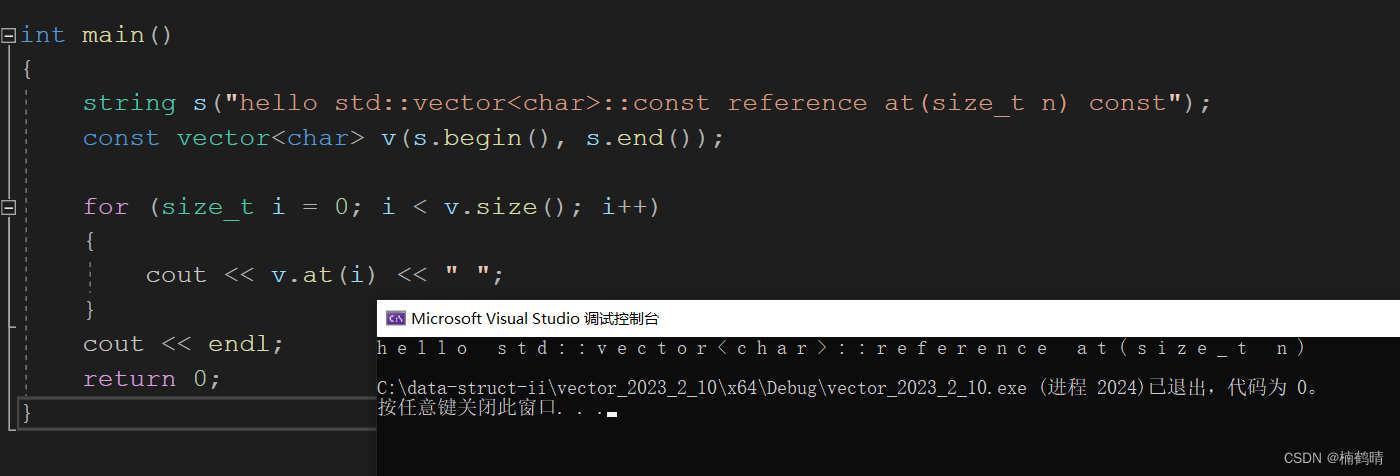
3. front()

- 代码:
int main()
{string s("hello std::vector<char>::front()");vector<char> v(s.begin(), s.end());cout << v.front() << endl;return 0;
}
运行结果:

4.back()

- 代码:
int main()
{string s("hello std::vector<char>::back()");vector<char> v(s.begin(), s.end());cout << v.back() << endl;return 0;
}
运行结果:

六、修改接口(Modifiers)
1. push_back()

- 代码:
int main()
{vector<int> v;v.push_back(1);v.push_back(2);v.push_back(3);v.push_back(4);v.push_back(5);v.push_back(6);vector<int>::iterator vit = v.begin();while (vit != v.end()){cout << *vit << " ";vit++;}cout << endl;return 0;
}
运行结果:
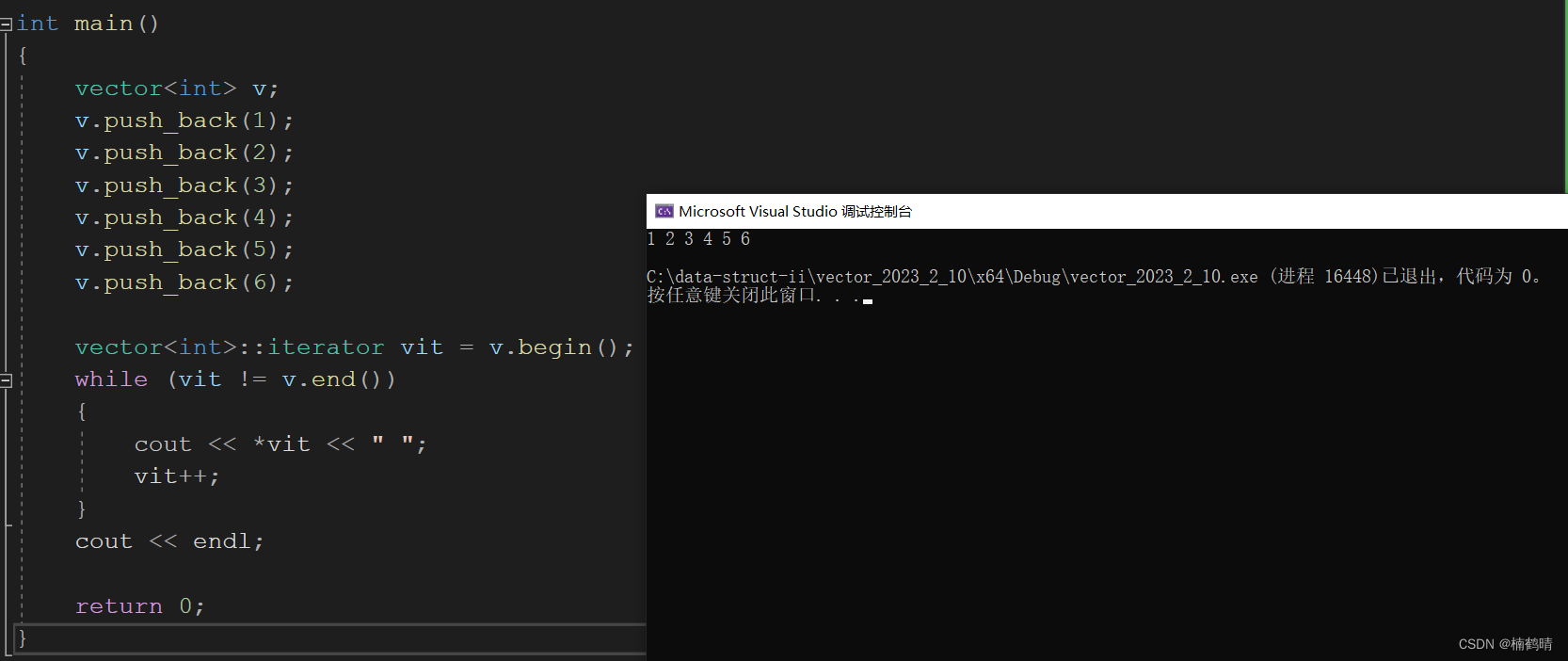
2. pop_back()

- 代码:
int main()
{string s("hello std::vector<char> pop_back()");vector<char> v(s.begin(), s.end());vector<char>::iterator vit = v.begin();while (vit != v.end()){cout << *vit << " ";vit++;}cout << endl;v.pop_back();v.pop_back();for (auto& ch : v){cout << ch << " ";}cout << endl;return 0;
}
运行结果:
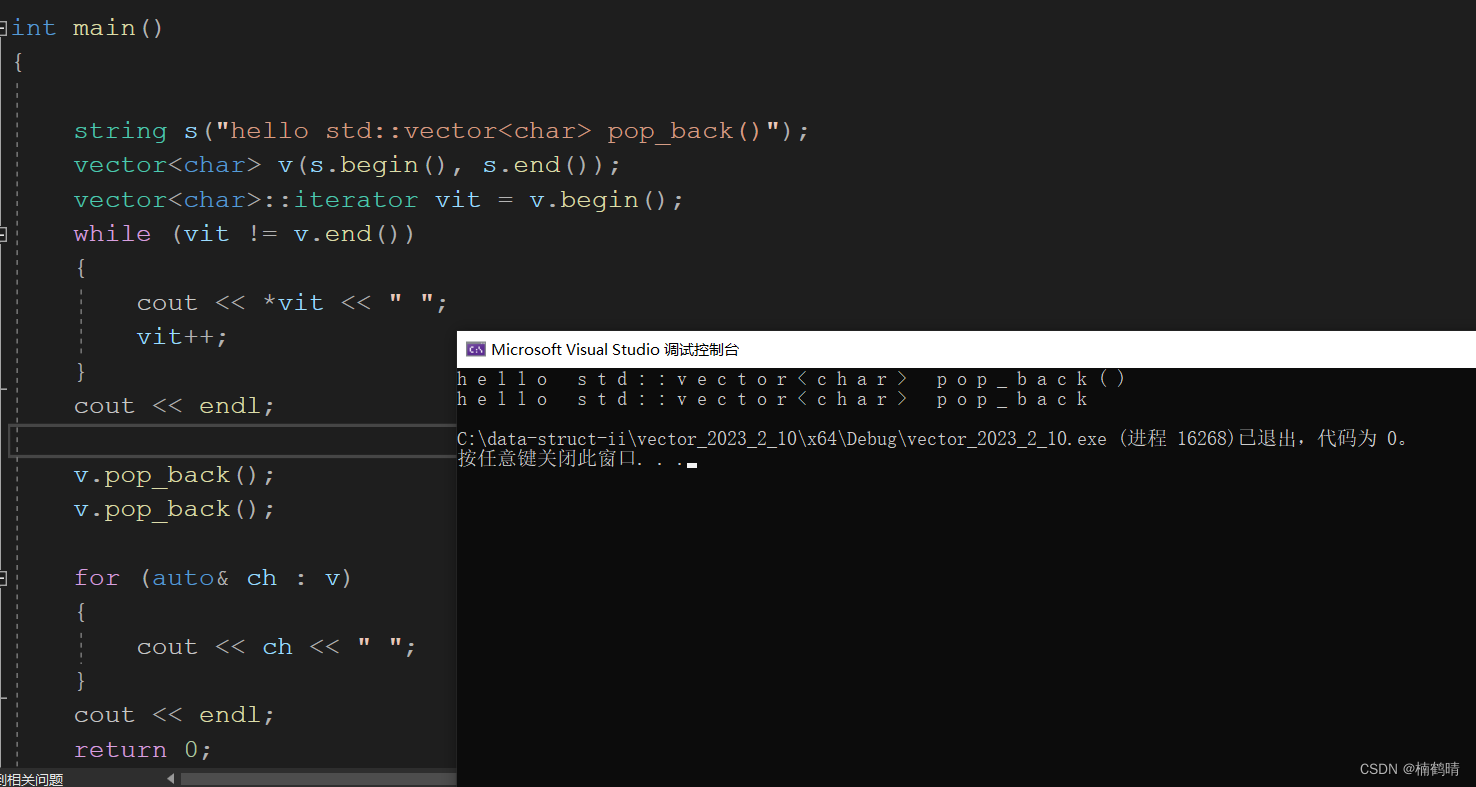
本文链接:https://my.lmcjl.com/post/7952.html
展开阅读全文

4 评论